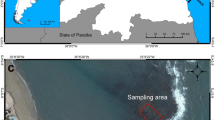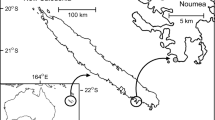Synopsis
The Hawaiian damselfish, Stegastes fasciolatus, defends an all-purpose territory on shallow-water reefs. By conceptually dividing each territory into 3 horizontal and 2 vertical zones, each intruder into the territory was recorded by species, zones violated, and reaction of the resident. Intruders included 3 herbivorous, 7 omnivorous, and 2 carnivorous species. A BMDP ‘4F’ analysis for multiway tables was applied to examine the relationships between the proximate causal factors eliciting the chase response by a resident. Species of intruder and their position in the territory had an additive effect on the chase response, with position in the territory as the less important factor. Distance from the bottom was not indicated as an important factor. The ecological implications of these results are discussed.
Similar content being viewed by others
References cited
Albrecht, H. 1969. Behavior of four species of Atlantic damselfishes from Columbia, South America (Abudefduf saxatilis, A. taurus, Chromis multilineata, C. cyanea); Pisces: Pomacentridae. Z. Tierpsychol. 26: 662–676.
Belk, M.S. 1975. Habitat partitioning in two tropical reef fishes, Pomacentrus lividus and P. albofasciatus. Copeia 4: 603–606.
Brawley, S.H. & W.H. Adey. 1977. Territorial behavior of threespot damselfish (Eupomacentrus planifrons) increases reef algal biomass and productivity. Env. Biol. Fish. 2: 45–51.
Colgan, P.W. & J.T. Smith. 1978. Multidimensional contingency table analysis. pp. 145–174. In: P.W. Colgan (ed.) Quantitative Ethology, J. Wiley & Sons, New York.
Collette, B. & F. Talbot. 1972. Activity patterns of coral reef fishes with emphasis on nocturnal-diurnal changeover. pp. 98–124. In: B. Collette & S.A. Earle (ed.) Results of the Tektite Program: Ecology of coral reef fishes, Los Angelos County, Nat. Hist. Mus. Sci. Bull. 14.
Ebersole, J.P. 1977. The adaptive significance of territoriality in the reef fish Eupomacentrus leucostictus. Ecology 58: 914–920.
Fagen, R.M. 1978. Repertoire analysis. pp. 25–43. In: P.W. Colgan (ed.) Quantitative Ethology, J. Whiley & Sons, New York.
Fienberg, S.E. 1977. The analysis of cross-classified categorical data. The M.I.T. Press, Cambridge. 151 pp.
Hobson, E.S. 1972. Activity of Hawaiian reef fishes during the evening and morning transitions between daylight and darkness. U.S. Fish. Bull. 70: 715–740.
Hobson, E.S. 1974. Feeding relationships of teleostean fishes on coral reefs in Kona, Hawaii. U.S. Fish. Bull. 72: 915–1031.
Itzkowitz, M. 1977. Spatial organization of the Jamaican damselfish community. J. Exp. Mar. Biol. Ecol. 28: 217–241.
Keenleyside, M.H.A. 1972. The behavior of Abudefduf zonatus (Pisces Pomacentridae) at Heron Island, Great Barrier Reef. Anim. Behav. 20: 763–774.
Kohda, M. 1981. Interspecific territoriality and agonistic behavior of temperate pomacentrid fish, Eupomacentrus altus (Pisces: Pomacentridae). Z. Tierpsychol. 56: 376–384.
Kohda, M. 1984. Intra- and interspecific territoriality of a temperate damselfish Eupomacentrus altus, (Teleostei: Pomacentridae). Physiol. Ecol. Japan 21: 35–52.
Lefebvre, L. & R. Joley. 1982. Organization rules and timing in kestrel grooming. Anim. Behav. 30: 1020–1028.
Losey, G.S. 1982. Ecological cues and experience modify interspecific aggression by the damselfish, Stegastes fasciolatus. Behavior 81: 14–37.
Low, R.M. 1971. Interspecific territoriality in a pomacentrid reef fish, Pomacentrus flavicuada Whitely. Ecology 52: 648–654.
Mahoney, B.M. 1981. An examination of interspecific territoriality in the dusky damselfish, Eupomacentrus dorsopunicans Poey. Bull. Mar. Sci. 31: 141–146.
Miller, R.J. 1978. Agonistic behavior in fishes and terrestrial invertebrates. pp. 281–311. In: E.S. Reese & F.J. Lighter (ed.) Contrasts in Behavior, J. Whiley & Sons, New York.
Moran, M.J. & P.L. Sale. 1977. Seasonal variation in territorial response, and other aspects of the ecology of the Australian temperate pomacentrid fish Parma microlepis. Mar. Biol. 39: 121–128.
Myrberg, A.A. 1972. Social dominance and territoriality in the bicolor damselfish, Eupomacentrus partitus (Poey) (Pisces: Pomacentridae). Behavior 41: 207–231.
Myrberg, A.A. & R.E. Thresher. 1974. Interspecific aggression and its relevance to the concept of territoriality in reef fishes. Amer. Zool. 14: 81–96.
Rasa, O.A.E. 1969. Territoriality and the establishment of dominance by means of visual cues in Pomacentrus jenkinsi (Pisces: Pomacentrus). Z. Tierpsychol. 26: 825–845.
Robertson, D.R. 1984. Cohabitation of competing territorial damselfishes on a Caribbean coral reef. Ecology 65: 1121–1135.
Smith, C.L. & J.C. Tyler. 1972. Space resource sharing in a coral reef fish community. pp. 125–170. In: B. Collette & S. Earle (ed.) Results of the Tektite Program: Ecology of Coral Reef Fishes, Los Angeles County, Nat. Hist. Mus. Sci. Bull. 14.
Thresher, R.E. 1976. Field experiments on species recognition by the three-spot damselfish, Eupomacentrus planifrons, (Pisces: Pomacentridae). Anim. Behav. 24: 526–569.
Vine, P.J. 1974. Effects of algal grazing and aggressive behaviour of the fishes Pomacentrus lividus and Acanthurus sohal on coral reef ecology. Mar. Biol. 24: 131–136.
Author information
Authors and Affiliations
Additional information
Senior author
Rights and permissions
About this article
Cite this article
Harrington, M.E., Losey, G.S. The importance of species identification and location on interspecific territorial defense by the damselfish, Stegastes fasciolatus . Environ Biol Fish 27, 139–145 (1990). https://doi.org/10.1007/BF00001943
Received:
Accepted:
Issue Date:
DOI: https://doi.org/10.1007/BF00001943




